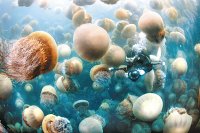 Schools of huge
Schools of hugeEchizen jellyfish...
off Wakasa Bay
in Maizuru,
Kyoto Prefecture.
Numbers of the jellyfish, which has an umbrella measuring about one meter in diameter, began increasing off the bay after Typhoon No. 13 passed over the Sea of Japan in mid-September.
______________________________________________
Meanwhile - off of the coast of California -
Giant turtle noshing jellyfish off Point Reyes
Sea turtles the size of sports cars are swimming off the Marin County coast, chowing down on jellyfish...
Leatherback turtles typically visit the California coast in the fall and congregate around Monterey Bay. This year, however, the turtles could be zeroing in on the Marin Coast instead.
The leatherback, an extremely rare reptile that tolerates waters too chilly for other sea turtles, can grow up to 9 feet long and weigh a ton. It's unclear why it's showing up so far north.
"You usually start hearing of sightings sometime in late summer or early fall," he said. "Last year, they were off the San Mateo coast, and now they appear to be north of the Golden Gate. Wherever they go, they're looking for jellyfish."
At least one large leatherback recently was spotted fairly close to the Point Reyes Peninsula, gobbling jellyfish the size of dinner plates....
______________________________________________
And in Canada (Qualicum Beach, Vancouver Island, British Columbia) -
Rash of dead jellyfish washing up
Beachcombers should be on alert, as the annual completion of the Lion's Mane jellyfishes' life cycle means the gelatinous creatures are washing up on shores across the region.
"We're getting a lot more along the coast this year. I'm not sure why," says Mary Arai, a professor emeritus at the University of Calgary who specializes in the aquatic creature. "If you handle them even after they're dead they will give you a rash."
The Lion's Mane ranges from the Arctic to Mexico and lives in Atlantic and Pacific waters. Their bells can reach more than two metres across with tentacles that trail as much as 30 metres. Juveniles are pink with colouring changing towards reddish brown or purple as they age.
In April, bottom dwelling polyps bud off of baby jellyfish. By July, juveniles have become full size. Adult males release sperm, where it's gathered by females who brood the eggs internally then release beings no larger than a pin, which drift to the bottom.
Most adults die by October due to bacterial infection or depleted plankton supplies. Arai says jellyfish on the beach aren't unusual.
"It's a matter of the life cycle. After they spawn they die and wash up on shore."
No comments:
Post a Comment